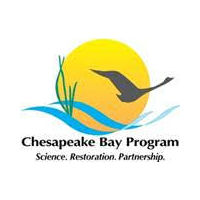
While computer simulations also show a drop in the amount of nitrogen entering the nation’s largest estuary, the partnership fell short of its pollution reducing target for nitrogen by 15 million pounds. According to the partnership’s Watershed Model, pollution controls put in place between 2009 and 2017 in Delaware, Maryland, New York, Pennsylvania, Virginia, West Virginia and the District of Columbia have lowered nitrogen, phosphorus and sediment loads by 11 percent, 21 percent and 10 percent, respectively.
Through the Chesapeake Bay Watershed Agreement, Chesapeake Bay Program partners committed to have in place all of the pollution reducing practices that would achieve the clean water standards of the Chesapeake Bay Total Maximum Daily Load (Bay TMDL) by 2025, with those practices that would achieve 60 percent of the necessary pollution reductions in place by 2017. Practices are currently in place to achieve 40 percent of the nitrogen reductions, 87 percent of the phosphorus reductions and 67 percent of the sediment reductions necessary to attain applicable water quality standards as compared to 2009, the year before the U.S. Environmental Protection Agency (EPA) established the Bay TMDL.
Water quality modeling experts attribute this drop in estimated pollution loads to technological upgrades of wastewater treatment plants and the increased implementation of agricultural best management practices (BMPs). The implementation of BMPs in both the agricultural and urban sectors will need to accelerate to close the gap in reducing nitrogen loads.
Facts
Each year, Delaware, Maryland, New York, Pennsylvania, Virginia, West Virginia and the District of Columbia report the pollution controls that they have implemented to reduce the nitrogen, phosphorus and sediment entering rivers and streams. Chesapeake Bay Program experts run this information through a suite of computer simulations known as the Watershed Model to generate pollution load estimates that determine how far our partners have come toward meeting the pollution reductions outlined in the Chesapeake Bay Total Maximum Daily Load (Bay TMDL).
Between 2009 and 2017, Chesapeake Bay Program computer simulations show:
- Nitrogen loads fell 11 percent, from 283 million pounds in 2009 to 253 million pounds in 2017. The 2017 nitrogen load is 15 million pounds above the 2017 nitrogen reducing target.
- Phosphorus loads fell 21 percent, from 19.2 million pounds in 2009 to 15.1 million pounds in 2017. The 2017 phosphorus reducing target has been exceeded by 1.3 million pounds.
- Sediment loads fell 10 percent, from 8.7 billion pounds in 2009 to 7.8 billion pounds in 2017. The 2017 sediment reducing target has been exceeded by 87 million pounds.
These pollution load estimates, which are derived from land use and best management practice implementation, are just one in a suite of tools the EPA uses to evaluate whether jurisdictions are on track to meet the Bay TMDL and its two-year milestone commitments. The EPA also considers data and information on best management practice implementation, best management practice effectiveness and jurisdictions’ progress toward putting programs in place to achieve pollution cuts. The EPA is expected to release its evaluations of jurisdictional progress toward their individual 2016-2017 milestones and the watershed-wide Bay TMDL this summer.
The Chesapeake Bay Program also uses water quality monitoring data to report the partnership’s progress in attaining water quality standards and to examine trends in reducing nitrogen, phosphorus and sediment in the watershed.
Issues
Excess nutrients and sediment are among the leading causes of the Chesapeake Bay’s poor health. Nitrogen and phosphorus can fuel the growth of algae blooms that lead to low-oxygen “dead zones” in deep waters and short-duration “mortality moments” in shallow waters. Sediment can block sunlight from reaching underwater grasses and suffocate shellfish. Pollution reducing practices in backyards, in cities and on farms can lower the flow of nitrogen, phosphorus and sediment into waterways.
Importance
By incorporating the best available data into our computer simulations and pollution load estimates, the Chesapeake Bay Program can more accurately track our partners’ progress toward their pollution-reducing goals. These data give local leaders the science-based information they need to assess their pollution reducing practices and adapt their management decisions as needed.
Jurisdictions’ progress toward reducing nutrient and sediment pollution is a product of their work to meet the Chesapeake Bay Total Maximum Daily Load (Bay TMDL). Jurisdictions’ Watershed Implementation Plans (WIPs) outline the strategies each will take to meet the Bay TMDL; these strategies are being implemented through a series of two-year milestones. The U.S. Environmental Protection Agency (EPA) oversees progress toward these goals.
Responses
“We continue to be encouraged by the decreasing nutrient and sediment loads entering the Bay, thanks in part to technological upgrades at wastewater treatment plants and the implementation of agricultural best management practices. As we move forward to 2025, it is imperative that we all increase our efforts, especially in reducing nitrogen pollution across all sectors, as we continue to work together to ensure that the partnership is successful in achieving a healthier Chesapeake Bay ecosystem.”
– Jim Edward, Acting Director, Chesapeake Bay Program
“As our region’s quality of life and economic vitality are strengthened by the Partnership’s commitment to a healthy Chesapeake Bay, we must hold ourselves accountable. Reaching the half-way point and falling short of our nitrogen goals demands that we take the lessons learned and improved tools to accelerate reductions through our Phase III Watershed Implementation Plans.”
– Matthew J. Strickler, Secretary, Department of Natural Resources, Commonwealth of Virginia
“Pennsylvania’s wastewater treatment plants, farms and urban areas in the watershed are all reducing phosphorous levels, with wastewater treatment plants already meeting their target. DEP and our many state and local partners are working hard, with new energy, ideas and commitment, to achieve a similar level of success in reducing nitrogen levels by 2025.”
– Patrick McDonnell, Secretary, Department of Environmental Protection, Commonwealth of Pennsylvania
“It is great to see our efforts have resulted in measurable improvements in the Bay’s health and its living resources. While we are encouraged by our progress towards phosphorus and sediment reductions, we must accelerate nitrogen reductions if we are to be successful in meeting our 2025 commitments.”
– Dinorah K. Dalmasy, Manager, Integrated Water Planning Program, Water and Science Administration, Maryland Department of the Environment and Co-Chair, Water Quality Goal Implementation Team
“It is no small feat that the region, as a whole, met its phosphorus and sediment goals. However, success in upgrading sewage treatment plants masks serious gaps in reducing pollution from agriculture and urban runoff. Unless efforts to tackle these sources are accelerated, we will not achieve the 2025 goals. Despite these shortfalls, we are seeing improvements in the Bay’s health. Those improvements, though, are at risk. Trump Administration proposals, including slashing funding from EPA’s Chesapeake Bay Program and rolling back regulations on emissions from power plants and vehicles threatens pollution-reduction progress. Air pollution is responsible for roughly one-third of the nitrogen that is damaging the Bay.”
– Beth McGee, Chesapeake Bay Foundation Director of Science and Agricultural Policy










